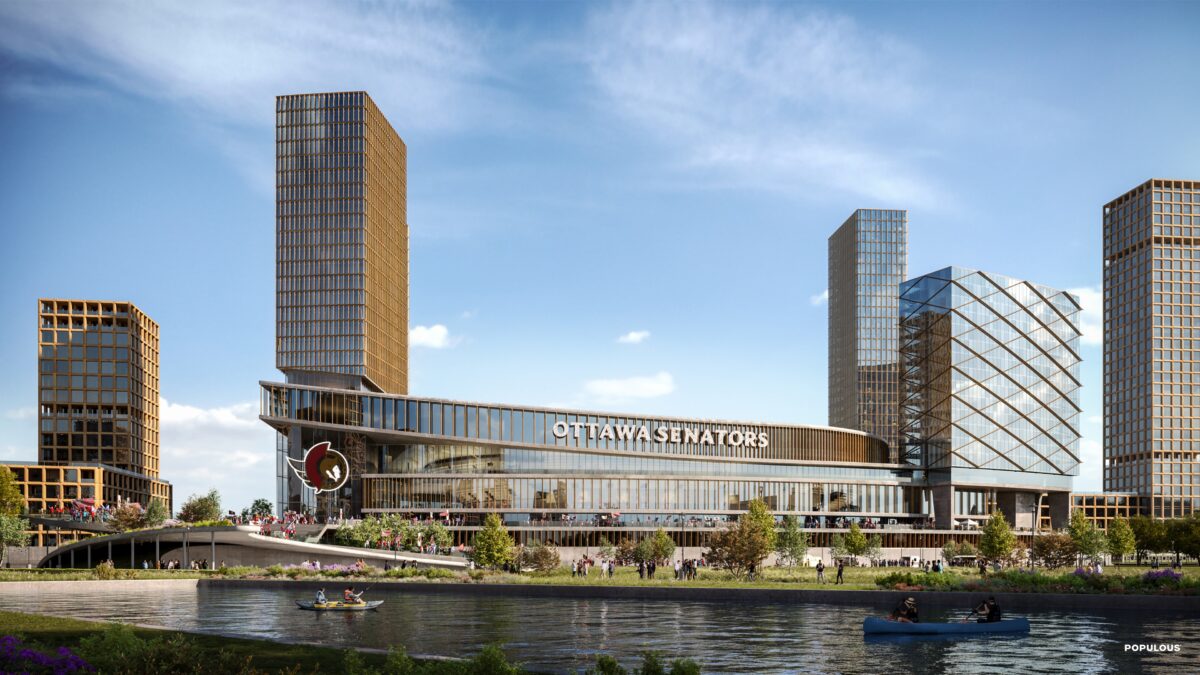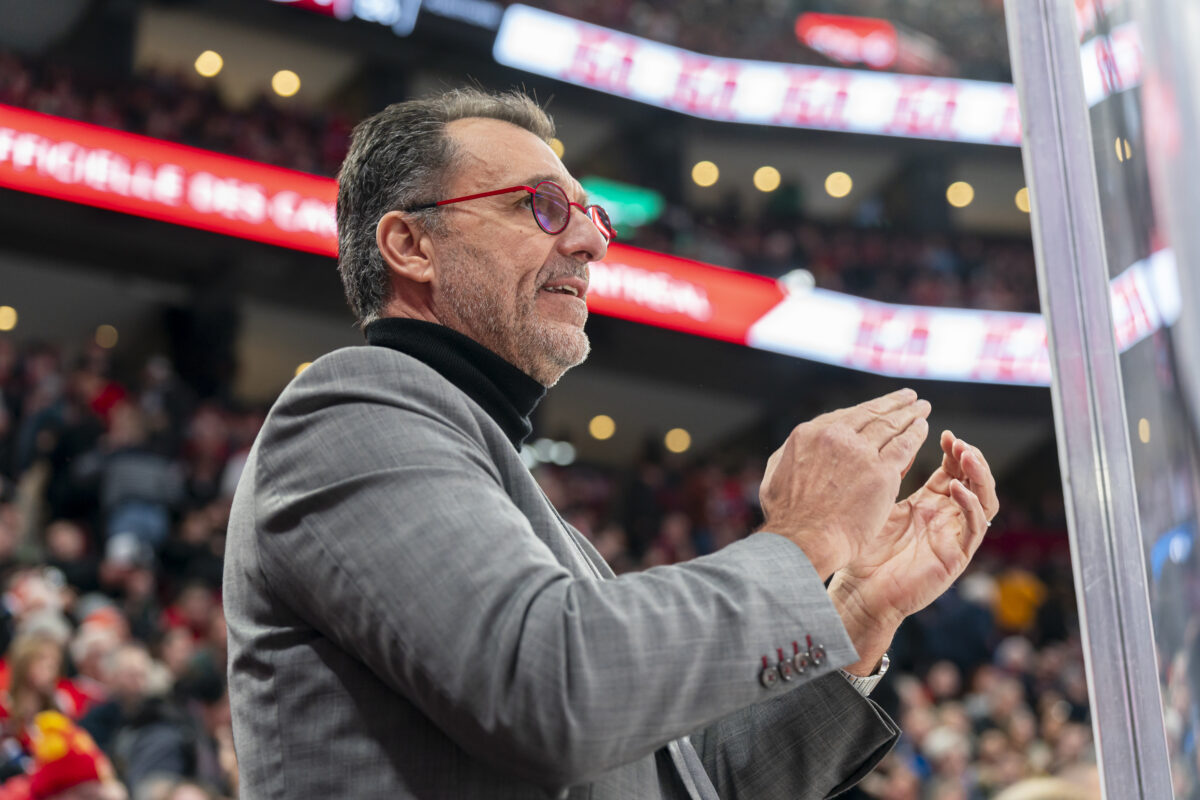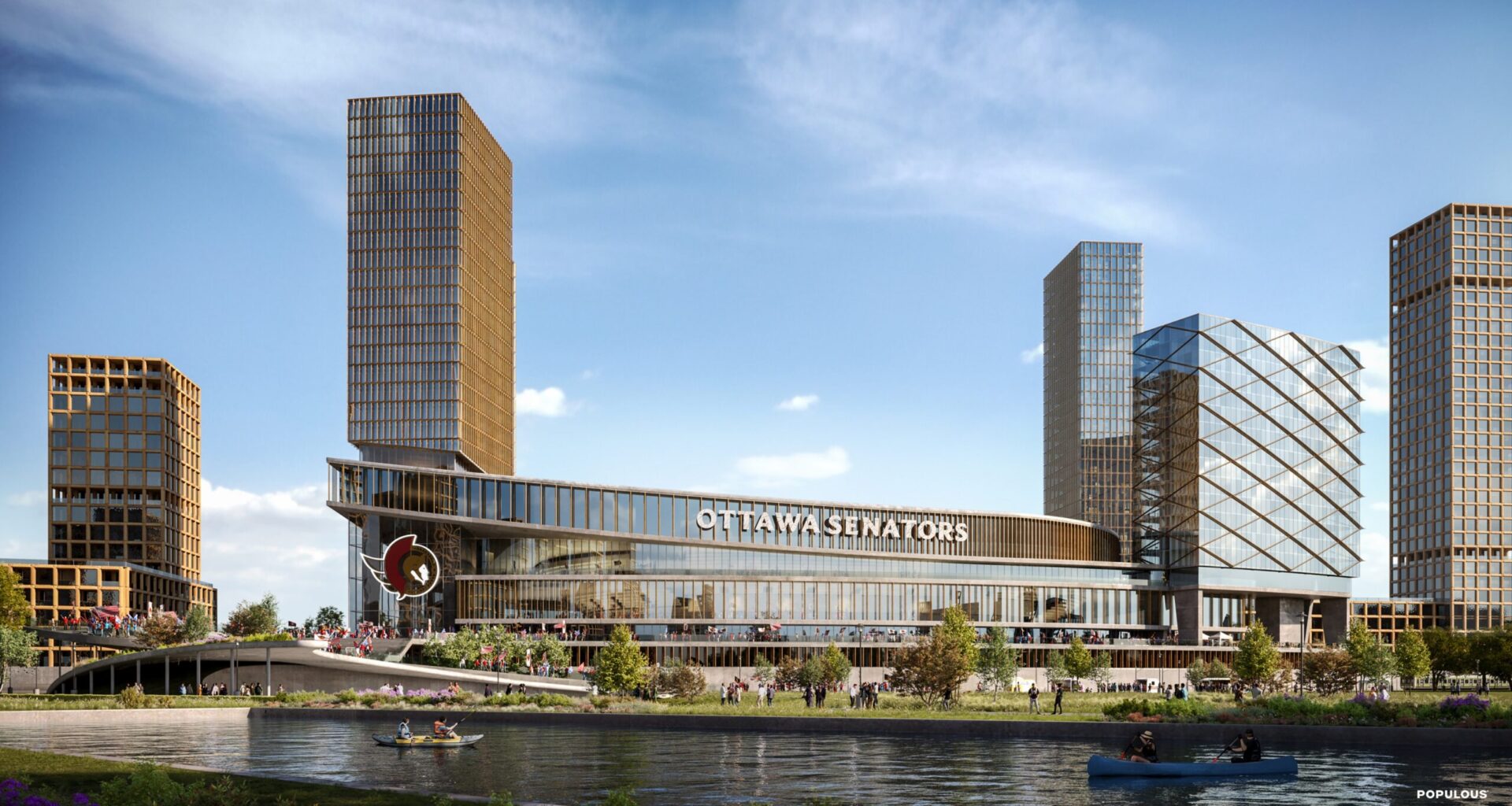On Aug. 11, the Ottawa Senators and the federal government’s National Capital Commission (NCC) inked a deal for the hockey club to buy 4.5 hectares of land at LeBreton Flats close to downtown Ottawa for the construction of a new arena.
To be sure, this is an important step toward moving the club out of its current Kanata digs – 25 kilometres west of the city core. Yet the deal is no guarantee the move will happen any time soon – or even at all. That’s because, as things stand now, moving downtown just doesn’t make financial sense.
Senators Must Know Move Downtown Is Risky
Cyril Leeder, the Senators’ president and CEO, must know that moving the Senators to LeBreton Flats is a high-risk move with potentially low returns – at least without major financial support from one or more levels of government.
 Artist Rendering of Proposed New Ottawa Senators Arena in LeBreton Flats (Photo – National Capital Commission)
Artist Rendering of Proposed New Ottawa Senators Arena in LeBreton Flats (Photo – National Capital Commission)
It’s perhaps why, on announcing the deal, Leeder seemed at pains to manage the expectations of the many fans who have spent more than three decades clamouring for the move. As he explained it, while the land purchase was “the next step in the process, there are still many more hurdles to clear in creating an event centre at LeBreton Flats.” As he pointed out in an interview almost one year ago, “(There is) a lot of heavy lifting to do. There are just too many parameters, too many variables to predict how long it’s going to take. I know it’s years, not months, before a shovel goes in the ground.”
Cost of New Arena for Senators Huge and Unpredictable
The purchase of the land for the new arena is arguably the easy part. It’s rumoured the team paid slightly more than $30 million for the 11-acre parcel.
Still, that outlay takes a sizeable one-time chunk out of the Senators’ annual regular season ticket revenue of an estimated $87 million. (That’s based on the 2024-25 average attendance of 17,306 per game at Canadian Tire Centre (CTC) with fans shelling out an average of $123 per ticket over 41 home games)
But the cost of the land isn’t all the Senators will need to recoup. Land decontamination could turn out to be a wild card in any Senators’ business case for the new arena. Almost 10 years ago, one expert estimated that the cost of decontaminating all of LeBreton Flats could be as much as $50 million (from Don Butler, ‘Decontaminating LeBreton sites could cost up to $50 million expert says,’ The Ottawa Citizen, 1/21/16). If that isn’t enough for backers of the new arena to think twice, another study released just two years later pegged the cost at $170 million.
All of this is to say that there is a high degree of uncertainty about how much it could cost the Senators to load, haul, handle and dispose of the highly contaminated soil believed to be lying on the 4.5 hectares it purchased. While the cost in 2016 was estimated at $3 million per hectare, it is probably many times higher nearly a decade later.
Still, all of this is small beer compared to the estimated $1 billion cost of a new NHL arena – a figure borne out by the price tag on the Calgary Flames’ new arena and event centre. It’s also one that climbs higher every year. It’s easy to dismiss all of this by saying that the Senators will make their money back on the real estate and entertainment district that goes along with the new arena. That’s fanciful and ignores the fact that, as it stands now, absent some level of government support, the Senators will have to come up with well over $1 billion in cold hard cash to get the project off the ground.
Uncertain Return on Investment in New Downtown Arena for Senators
First-year accounting students at Carleton University are smart enough to calculate a quick return on investment (ROI) on the new arena. I’d wager they’d have a hard time finding one that wasn’t coloured bright red if the Senators need to spend well north of $1 billion of their own money on the new rink.
First, it’s doubtful that the Senators will be able to sell many more tickets if they move downtown. Last season, they were at capacity on many nights, and on the season as a whole, average attendance matched that of the league. In all, ticket sales in the regular season ran at about 93% of CTC’s total capacity of 18,500 hockey fans.
 Canadian Tire Centre (Jeff Morris/THW)
Canadian Tire Centre (Jeff Morris/THW)
Secondly, there’s not much chance that Senators’ fans would be willing to pay more for the privilege of watching games downtown. The price of Senators’ tickets during the regular season is laughably low. In Canada, fans on average pay between CAD$257.30 and CAD$443.57 per ticket, while in the United States, American hockey-goers can pay as little as USD$123 per ticket but as much as USD$460.72 (from Rebecca Tauber and Mark Puleo, ‘What did it cost to be an NHL fan during the 2024-25 regular season?,’ The Athletic, 4/19/25).
There’s a good reason the Senators can’t charge more than they do for tickets during the regular season. The corporate sector in the Ottawa region is comparatively tiny relative to other NHL cities. Let’s face it, the major industry on the Rideau Canal is governing Canada. Civil servants generally don’t make the kind of money needed to spend lavishly on tickets to NHL hockey games. What’s more, government departments don’t blow big money on luxury suites to entertain clients. (could they tag it as defence spending now that we’re committed to spending 5% of gross domestic product on that?)
A lot of the money needed to buy expensive tickets to see the Senators play is found in Kanata’s high-tech parks – within a stone’s throw of where the Senators already play. It’s hard to see how moving 25 kilometres away to a new rink in downtown Ottawa helps the team sell more luxury boxes to companies and more season tickets to well-heeled high-tech executives and software engineers. Making the problem with a downtown arena and entertainment district even worse is that the federal government has moved to a hybrid work model under which most government workers go into the office just three days per week. The only time Ottawa’s downtown core has been emptier was during COVID.
There’s no reliable data regarding where the Senators’ season ticket holders and single-game ticket purchasers live. Even so, with half of Ottawa’s population living in its western suburbs, it’s hard not to believe that the majority of tickets the team now sells are to people living in them. Moving downtown increases the commute time and cost for this key market segment.
What’s more, there’s good reason to believe that these fans prefer the convenience of driving to games along with easy parking – something CTC offers in abundance. It’s hard to fathom how having to take a combination of buses and the city’s notoriously unreliable and limited light rail transit system (LRT) to see the Senators play at LeBreton Flats would make many of them very happy. All things considered, there is a very real risk that a move to LeBreton Flats would actually shrink the team’s paying fan base with no guarantee that new fans would replace them.
There is an argument that younger fans who don’t have cars would replace any west end fans the team loses with the move to LeBreton Flats. That seems far-fetched since carless young fans probably don’t have extra money to spend on hockey tickets. The first clue is that they don’t own a car! What’s more, younger people tend to be saddled with high rents or huge mortgages, leaving precious little left over for such frivolities as NHL tickets.
Some say that a new arena would draw in new tourists and many more top entertainment acts to Ottawa. Yet does anyone really think tourists would flock to Ottawa to see its new downtown arena? People come to Ottawa to see Canada’s seat of government. As for big-name acts performing in the new arena, most of them bypass Ottawa to entertain crowds in Toronto and Montreal. Not only that, but acts like Taylor Swift play to crowds of 60,000 – more than three times the capacity of any new building the Senators are likely to put up.
Some argue that there is “branding value”, such as naming rights, in having the Senators relocate to Ottawa’s central core. Yet how do the Senators factor hazy projected profits like those into a hard business case? What’s more, the value of the Senators’ brand extends no farther than a one-hour radius around Parliament Hill. Go beyond that and you’re in Toronto Maple Leafs or Montreal Canadiens territory. Additional profit from the putative branding value of a new LeBreton Flats venue is likely to be small.
Senators’ Move to LeBreton Flats Needs Government Support
Any way you look at the financial side of moving the Senators downtown, it always involves some level of government support to make it work. There’s simply no way that increased ticket revenue, even if it were to magically appear, would push the project into positive ROI territory. Debt servicing and capital costs would kill the business case. There is a very real risk that the Senators would overextend themselves financially on the project if free money weren’t made available to them by one or more levels of government.
Related: Why Do Cities Still Publicly Fund New NHL Arenas
The Senators themselves have been hinting at this for the past several years. Team owner Michael Andlauer was categorical in a 2024 interview explaining that the new arena, “cannot happen without public support” (from Bruce Garrioch, ‘Ottawa Senators owner Michael Andlauer on LeBreton deal: I think we’ll get there,’ The Ottawa Citizen, 9/11/24). Some will argue Andlauer is wrong, pointing out that Bell Centre in Montreal, Scotiabank Arena in Toronto and Rogers Arena in Vancouver were built largely without government money. Yet these exceptions prove the rule – experience shows that while new rinks can be built with just private money in large hockey markets, they can’t be in small markets like Ottawa.
 Michael Andlauer, Owner of the Ottawa Senators (Photo by Arianne Bergeron/NHLI via Getty Images)
Michael Andlauer, Owner of the Ottawa Senators (Photo by Arianne Bergeron/NHLI via Getty Images)
Take Calgary, for example. The new arena that will house the Calgary Flames comes with a price tag of $926.4 million. Of that, the City of Calgary is on the hook for $850.3 million while the Province of Alberta is kicking in $30 million. The Flames’ owner, the Calgary Sports and Entertainment Corporation (CSEC), will pony up $40 million but enjoy a sweetheart lease agreement under which they’ll pay $17 million each year compounded at an annual rate of just 1% for 35 years. All told, John Q. Taxpayer in Calgary is covering over 90% of the cost of the Flames’ new arena.
Of the five new NHL arenas that opened in the last 10 years, just two needed government support – Rogers Place in Edmonton and Little Caesars Arena in Detroit. The remaining three – the New York Islanders’ UBS Arena, the Vegas Golden Knights’ T-Mobile Arena and the Seattle Kraken’s Climate Pledge Arena were launched with no public money.
What is important to keep in mind, though, is that these arenas are multipurpose facilities hosting many events each year, ranging from National Basketball Association (NBA) games, college basketball, professional wrestling, mixed martial arts and large concerts. Ottawa is too small to attract the kind and number of entertainment events that Las Vegas, Long Island and Seattle can.
Given that it’s Ottawa, I wouldn’t blame any owner of the Senators for demanding public money to build a new rink at LeBreton Flats. Sure, many will dismiss that as socialism for capitalists, but it’s not like the Senators are the ones pressuring for the move. It’s their fans outside of the city’s west end and city politicians desperate to revitalize a moribund downtown. None of them seem to understand that any new investment, new businesses and new jobs that a new arena creates downtown just offsets losses in the west end.
Even located at CTC far outside the city core, the Senators still get sellout crowds. So why leave? How would they be better off in LeBreton Flats than they are in Kanata, especially after spending over $1 billion of their own money on a new arena, as many of their entitled fans expect them to do? It’s hard to see how they could generate a return on that investment. That is, again, unless one or more levels of government come to the rescue and pick up the lion’s share of the cost of the new rink.
Senators Could Be in Kanata for a Long Time
The Senators’ Kanata home may not be as glamorous as a spiffy new arena downtown, but there’s a good chance that’s where fans will be watching them play for years to come. There are many high hurdles to clear before construction starts at LeBreton Flats – despite all the high hopes the land purchase raised.


